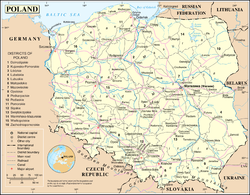Poland
| Republic of Poland
Rzeczpospolita Polska (Polish)
| |
|---|---|
![Location of Poland (dark green)– in Europe (green & dark grey)– in the European Union (green) – [Legend]](https://upload.wikimedia.org/wikipedia/commons/thumb/9/9b/EU-Poland.svg/250px-EU-Poland.svg.png)
Location of Poland (dark green)
| |
 | |
| Capital and largest city | Warsaw 52°13′N 21°02′E |
| Official languages | Polish[1] |
| Minority languages | Kashubian, German, Ukrainian, Belarusian, Rusyn, Romani, Yiddish[2] |
| Ethnic groups(2011[3]) | |
| Religion (2011[4]) |
|
| Demonym | |
| Government | Unitary semi-presidentialrepublic |
| Andrzej Duda | |
| Mateusz Morawiecki | |
| Legislature | National Assembly |
| Senate | |
| Sejm | |
| Formation | |
| 14 April 966 | |
| 18 April 1025 | |
| 1 July 1569 | |
| 24 October 1795 | |
| 22 July 1807 | |
| 9 June 1815 | |
| 11 November 1918 | |
| 1 September 1939 | |
| 8 April 1945 | |
| 13 September 1989 | |
| 1 May 2004 | |
| Area | |
• Total
| 312,679 km2(120,726 sq mi)[a] (69th) |
• Water (%)
| 3.07 |
| Population | |
• 30 June 2017 estimate
| 38,422,346[5] (35th) |
• Density
| 123/km2 (318.6/sq mi) (83rd) |
| GDP (PPP) | 2017 estimate |
• Total
| $1,110 billion[6] (21st) |
• Per capita
| $29,250 |
| GDP (nominal) | 2017 estimate |
• Total
| $509.955 billion[6] (23rd) |
• Per capita
| $13,429 |
| Gini (2014) | medium |
| HDI (2015) | very high · 36th |
| Currency | Polish złoty (PLN) |
| Time zone | CET (UTC+1) |
• Summer (DST)
| CEST (UTC+2) |
| Drives on the | right |
| Calling code | +48 |
| ISO 3166 code | PL |
| Internet TLD | .pl |
Website
poland.pl | |
| |
Poland (Polish: Polska [ˈpɔlska] ( listen)), officially the Republic of Poland (Polish: Rzeczpospolita Polska,[a]
listen)), officially the Republic of Poland (Polish: Rzeczpospolita Polska,[a]  listen (help·info)), is a sovereign country in Central Europe.[11] It is a unitary state divided into 16 administrative subdivisions, covering an area of 312,679 square kilometres (120,726 sq mi) with a mostly temperate climate.[9] With a population of over 38.5 million people, Poland is the sixth most populous member state of the European Union.[9] Poland's capital and largest city is Warsaw. Other cities include Kraków, Łódź, Wrocław, Poznań and Gdańsk.
listen (help·info)), is a sovereign country in Central Europe.[11] It is a unitary state divided into 16 administrative subdivisions, covering an area of 312,679 square kilometres (120,726 sq mi) with a mostly temperate climate.[9] With a population of over 38.5 million people, Poland is the sixth most populous member state of the European Union.[9] Poland's capital and largest city is Warsaw. Other cities include Kraków, Łódź, Wrocław, Poznań and Gdańsk.
The establishment of a Polish state can be traced back to 966, when Mieszko I,[12] ruler of a territory roughly coextensive with that of present-day Poland, converted to Christianity. The Kingdom of Poland was founded in 1025, and in 1569 it cemented a longstanding political association with the Grand Duchy of Lithuania by signing the Union of Lublin. This union formed the Polish–Lithuanian Commonwealth, one of the largest (about 1 million km²) and most populous countries of 16th and 17th century Europe, with a uniquely liberal political system[13][14] which adopted Europe's first written national constitution, the Constitution of 3 May 1791.
Following the partitions of Poland at the end of the 18th century, Poland regained its independence in 1918 with the Treaty of Versailles. In September 1939, World War II started with the invasion of Poland by Nazi Germany, followed by the Soviet Unioninvading Poland in accordance with the Molotov–Ribbentrop Pact. More than six million Poles died in the war.[15][16] After World War II, the Polish People's Republic was established as a satellite state under Soviet influence.[17] In the aftermath of the Revolutions of 1989, most notably through the emergence of the Solidarity movement, Poland established itself as a democratic republic.
Poland is a developed market and regional power as well as a possible emerging world power.[18] It has the eighth largest and one of the most dynamic economies in the European Union,[19][20] simultaneously achieving a very high rank on the Human Development Index.[21] Additionally, the Polish Stock Exchange in Warsaw is the largest and most important in Central and Eastern Europe.[22]Poland is a developed[23] and democratic country, which maintains a high-income economy[24] along with very high standards of living, life quality,[25] safety, education and economic freedom.[26][27] According to the World Bank, Poland has a leading school educational system in Europe.[28][29] The country provides free university education, state-funded social security and a universal health care system for all citizens.[30][31] Situated between Eastern and Western European cultures and having an extensive history, Poland has developed a rich cultural heritage, including numerous historical monuments. It has 15 UNESCO World Heritage Sites, 14 of which are cultural.[32] It is visited by approximately 17.5 million tourists every year (2016), making it the 16th most visited country in the world.[33] Poland is a member state of the European Union, the Schengen Area, the United Nations, United Nations Security Council (2018-2019), NATO, the OECD and the Visegrád Group.




No comments:
Post a Comment